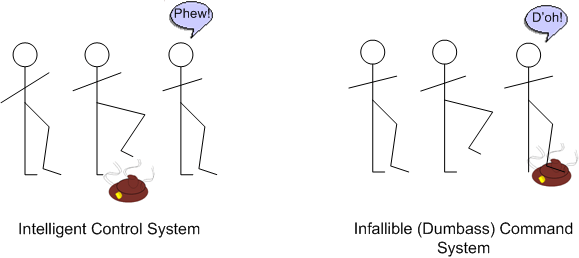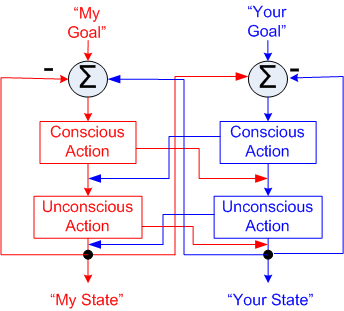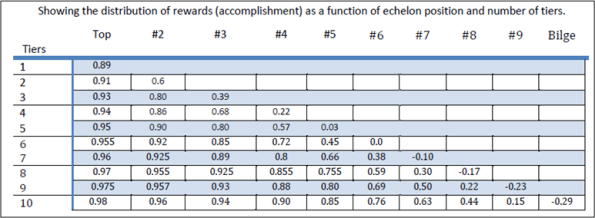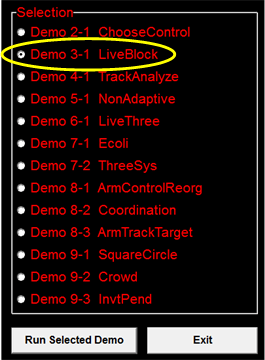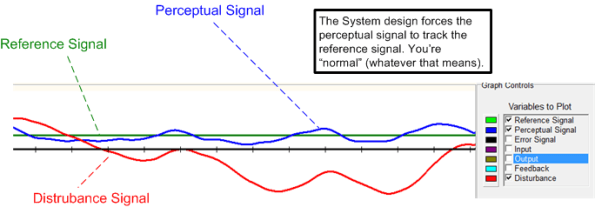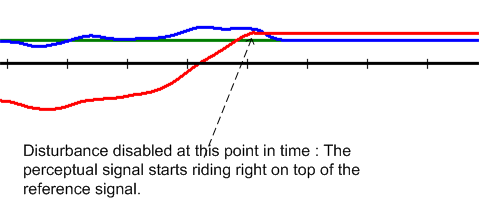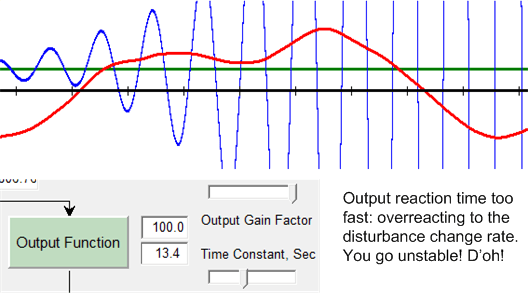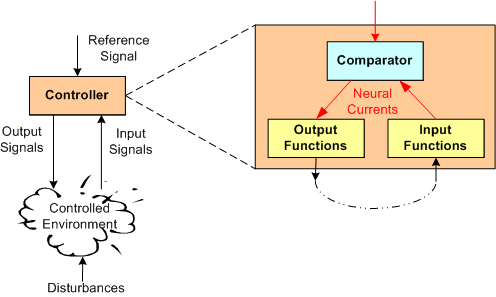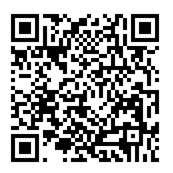Archive
Four Reasons
When I don’t do something that I’m “supposed” to do, it comes down to one of two reasons:
- I don’t know how to do it because of a lack of expertise/experience (ability).
- I don’t believe it adds any, or enough, value (motivation).
But wait, I lied! There are also two more potential, but publicly undiscussable reasons. They’re elegantly put into words by Mr. Alexander Hamilton:
Men often oppose a thing merely because they have had no agency in planning it, or because it may have been planned by those whom they dislike. – Alexander Hamilton
How about you? When you don’t do something expected of you, why don’t you do it?
Command Vs. Control
One of the acronyms in BD00’s evil glossary is “CCH“. It stands for “Command and Control Hierarchy” because BD00 thought that command and control were fused together like Forrest Gump‘s peas and carrots. However, In “Making Sense Of Behavior“, Bill Powers distinguishes between a command hierarchy and a control hierarchy in an interesting way.
In a command hierarchy, a command dictates a specific action (git ‘r done!). In a control hierarchy, a command is a reference signal that specifies the state in which a particular perception is desired to be at in a future point in time; a vision, if you will.
For example, a sequence controlling system doesn’t order the limbs to be in a particular configuration; it tells a lower level control system to perceive the limbs as being in a particular position, then another, then another. By receiving a less specific reference signal, the lower level position control system can compensate for unforeseen disturbances (wind, gravity, physical obstructions) without distracting the higher level control system from its purpose.
Building The Perfect Beast
The figure below illustrates a simplified model of a Starkermann dualism. My behavior can contribute to (amity), or detract from (enmity) your well being and vice versa.
Mr. Starkermann spent decades developing and running simulations of his models to gain an understanding of the behavior of groups. The table below (plucked from Bill Livingston’s D4P4D) shows the results of one of those simulation runs.
The table shows the deleterious effects of institutional hierarchy building. In a single tier organization, the group at the top, which includes everyone since no one is above or below anybody else, attains high levels of achievement (89%). In a 10 layer monstrosity, those at the top benefit greatly (98% achievement) at the expense of those dwelling at the bottom – who actually gain nothing and suffer the negative consequences of being a member of the borg.
What do you think? Does this model correspond to reality? How many tiers are in your org and where are you located?
Normal, Slave, Almost Dead, Wimp, Unstable
Mr. William T. Powers is the creator (discoverer?) of “Perceptual Control Theory” (PCT). In a nutshell, PCT asserts that “behavior controls perception“. His idea is the exact opposite of the stubborn, entrenched, behaviorist mindset which auto-assumes that “perception controls behavior“.
This (PCT) interpretation of behavior is not like any conventional one. Once understood, it seems to match the phenomena of behavior in an effortless way. Before the match can be seen, however, certain phenomena must be recognized. As is true for all theories, phenomena are shaped by theories as much as theories are shaped by phenomena. – Bill Powers
On the Living Control Systems III web page, you can download software that contains 13 interactive demos of PCT in action:
The other day, I spent several hours experimenting with the “LiveBlock” demo in an attempt to understand PCT more deeply. When the demo is launched, the majority of the window is occupied by a fundamental, building-block feedback control system:
When the “Auto-Disturbance” radio option in the lower left corner is clicked to “on“, a multi-signal time trace below the model springs to life:
As you can see, while operating under stable, steady-state circumstances, the system does what it was designed to do. It purposefully and continuously changes its “observable” output behavior such that its internal (and thus, externally unobservable) perceptual signal tracks its internal reference signal (also externally unobservable) pretty closely – in spite of being continuously disturbed by “something on the outside“. When the external disturbance is turned off, the real-time trace goes flat; as expected. The perceptual signal starts tracking the reference signal dead nutz on the money such that the difference between it and the reference is negligible:
The Sliders
Turning the disturbance signal “on/off” is not the only thing you can experiment with. When enabled via the control panel to the left of the model (not shown in the clip below), six parameter sliders are displayed:
So, let’s move some of those sliders to see how they affect the system’s operation.
The Slave
First, we’ll break the feedback loop by decreasing the “Feedback Gain” setting to zero:
Almost Dead
Next, let’s disable the input to the system by moving the “Input Gain” slider as far to the left as we can:
The Wimp
Next, let’s cripple the system’s output behavior by moving the “Output Gain” slider as far to the left as we can:
Let’s Go Unstable!
Finally, let’s first move the “Input Delay” slider to the right to decrease the response time and then subsequently move the “Output Time Constant” slider to the left to increase the reaction time:
So, what are you? Normal, a slave, almost dead, a wimp, or an unstable wacko (like BD00)?
I’ve always been pretty much a blue-collar type, by training and by preference. – Bill Powers
Related articles
- Nine Plus Levels (bulldozer00.com)
- Extrapolation, Abstraction, Modeling (bulldozer00.com)
Extrapolation, Abstraction, Modeling
In the beginning of his book, “Behavior: The Control Of Perception“, Bill Powers asserts that there are three ways of formulating a predictive theory of behavior: extrapolation, abstraction, and modeling.
Extrapolation and abstraction are premised on accumulating a collection observations of behaviors and ferreting out recurring patterns applicable under many contexts and input situations. Modeling goes one level deeper and is based on formulating an organizational structure of the internal mechanisms that cause the observed behaviors.
For 30 years prior to the discovery/development/refinement of control theory (and continuing on today because of entrenched mindsets), psychologists and sociologists formulated theories of behavior based on extrapolation and abstraction. Because the human nervous system and brain were (and still are) unfathomably complex, they didn’t even try to model any underlying mechanisms. They treated organisms as dumb-ass, purposeless, “black box” responders to stimuli.
Bill Powers didn’t accept the superficial approaches and black box conclusions of the social “sciences” crowd. He went deeper and turned opaque-black into transparent-white with the relentless modeling and testing of his control system hypothesis of behavior:
Note that in Bill’s model, there is an internal goal that determines the response to a given “disturbance“. Thus, given the same disturbance at two different points in time, the white box model can generate different responses whereas the black box model would always generate the same response.
For example, the white box model explains anomalies like why, on the 100th test run, a mouse won’t press a button to get a food pellet as it did on the 99 previous runs. In this case, the internal goal may be to “eat until satiated“. When the internal goal is achieved, the externally observed behavior changes because the stimulus is no longer important to the mouse.
Theories based on extrapolation and abstraction are useful for predicting short term actions and trends within a certain probability, but when a physical model of the underlying mechanisms of a phenomenon is discovered, it explains a lot of anomalies unaccounted for by extrapolation/abstraction.
For a taste of Mr. Powers’ control system-based theory of behavior, download and experiment with the software provided here: Living Control Systems III.
Nine Plus Levels
In William T. Powers’ classic and ground-breaking book “Behavior: The Control Of Perception“, Mr. Powers derives a theoretical model of the human nervous system as a stacked, nine-level hierarchical control system that collides with the standard behaviorist stimulus-response model of behavior. As the book title conveys, his ultimate heretical conclusion is that behavior controls perception; not vice-versa.
The figure below shows a model of a control system building block. The controller’s job is to minimize the error between a “reference signal” (that originates from “somewhere” outside of the controller) and some feature in the external environment that can be “disturbed” from the status quo by other, unknown forces in the environment.
Notice that the comparator is one level removed from physical reality via the transformational input and output functions. An input function converts a physical effect into a simplified neural current representation and an output function does the opposite. Afterall, everything we sense and every action we perform is ultimately due to neural currents circulating through us and being interpreted as something important to us.
So, what are the nine levels in Mr. Powers’ hierarchy, and what is the controlled quantity modeled by the reference signal at each level? BD00 is glad you asked:
Starting at the bottom level, the controlled variables get more and more abstract as we move upward in the hierarchy. Mr. Powers’ hierarchy ends at 9 levels only because he doesn’t know where to go after “concepts“.
So, who/what provides the “reference signal” at the highest level in the hierarchy? God? What quantity is it intended to control? Self-esteem? Survival? Is there a “top” at all, or does the hierarchy extend on to infinity; driven by evolutionary forces? The ultimate question is “who’s controlling the controller?“.
This post doesn’t come close to serving justice to Mr. Powers’ work. His logical, compelling, and novel derivation of the model from the ground up is fascinating to follow. Of course, I’m a layman but it’s hard to find any holes/faults in his treatise, especially in the lower, more concrete levels of the hierarchy.
Note: Thanks once again to William L. Livingston for steering me toward William T. Powers. His uncanny ability to discover and integrate the work of obscure, “ignored”, intellectual powerhouses like Mr. Powers into his own work is amazing.
Human_Being:preserveSelf
As the UML sequence diagram below shows, an “unnamed” Nature object with an infinite lifeline asynchronously creates and, uh, kills Human_Being objects at will. Sorry about that.
So, what’s this preserveSelf routine that we loop on until nature kicks our bucket? I’m glad you asked:
Have a nice day! 🙂
Change In Behavior
“Change your thinking, and your behavior will change.” How many times have you heard or seen that sentence? Of course, it’s true, but as ever, the devil’s in the details. In my case, I’ve often fooled myself into thinking that my thinking has changed when it really hasn’t. So, the question is, who are “I” and “myself” in the previous sentence?
Super Secret Recipe
Wanna know what the super secret recipe is for building an impenetrable UCB pyramid? OK, you said no – but that t’aint gonna stop me from loosening my lips and sinking ships. Here we go…..
- Directly or (better yet) vicariously experience a real-life situation involving people in which the outcome is a “surprise” to you.
- Judge the outcome as absolutely good or bad (no gradations allowed!)
- Strip and discard all messy contextual meaning from the situation.
- If you judged the outcome as “good”, then ignore it and kick out of this recipe – you’re done! Otherwise…..
- Concoct a reason why the outcome turned out “bad”.
- By removing all the uncomfortable details that don’t align with your existing UCB, vertically abstract your interpretation of the reason for the outcome.
- Horizontally generalize your cause-effect conclusion to subsume any and all situations with any remote resemblance to the experienced situation.
- Pour mental concrete around your newly discovered nugget of knowledge and jam it somewhere into your growing UCB pyramid.
- Pat yourself on the back for “knowing” how the world worx. Whoo Hoo!
Every man, wherever he goes, is encompassed by a cloud of comforting convictions, which move with him like flies on a summer day. – Bertrand Russell
Past, Present, Future
I can’t remember who said it, but;
Feedback is information given in the present about behavior in the past that can be used to modify behavior in the future.
Just because feedback can be used to modulate future behavior doesn’t mean it actually will be used. Depending on the quality of the relationship between the feedback provider and the feedback receiver, the feedback may be taken to heart or it may be ignored. If the feedback receiver has little respect for the feedback provider, regardless of whether the provider is the receiver’s so-called “superior”, the feedback will be ignored. Oh sure, the receiver’s behavior may appear to superficially change out of fear, but counterproductive behind-the-scenes behavior will be guaranteed if the feedback is delivered as an “or else” ultimatum. On the other hand, if there is a two way connection of respect and trust between provider and receiver, the receiver’s behavior may change – if the receiver agrees with the provider’s assessment and it strikes an emotional chord within the receiver’s being.
Emotional energy, not logical deduction, is the driver of behavior. So stop being puzzled when people don’t behave “logically”.

